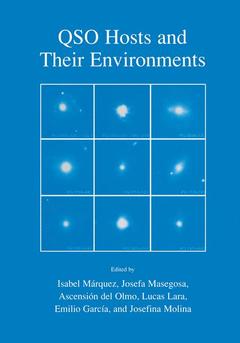Description
QSO Hosts and Their Environments, 2001
Coordinators: Márquez Isabel, Masegosa Josefa, del Olmo Ascensión, Lara Lucas, García Emilio, Molina Josefina
Language: English
Subjects for QSO Hosts and Their Environments:
Keywords
Population; Redshift; active galactic nuclei; astronomy; galaxies; quasar; quasars; spectroscopy; star; star formation
QSO Hosts and Their Environments
Publication date: 10-2012
376 p. · 17.8x25.4 cm · Paperback
Publication date: 10-2012
376 p. · 17.8x25.4 cm · Paperback
QSO hosts and their environments
Publication date: 01-2002
398 p. · Hardback
Publication date: 01-2002
398 p. · Hardback
Description
/li>Contents
/li>
Advanced technologies in astronomy at various wavelengths have provided us with high resolution and high quality data on the QSO population. This meeting was aimed at understanding the morphology and nature of the host galaxies and environments of QSOs. The invited lectures as well as the contributed and poster papers highlighted the main issues of current research: the stellar and gaseous content of the underlying galaxy; the characterization of the population of companions and the nature of their interaction with the host galaxy; the connection between radio-loud QSO and radio-galaxies, and QSOs and ULIRGs; the evolution with redshift of both the host galaxy and its environment, and the main implications in theories of galaxy formation and evolution. This volume provides a valuable overview and timely update of the exciting and rapidly developing field of QSO hosts and their environments - essential reading for graduate students and researchers.
Preface. Part I: Radio quiet/loud dichotomy. Unification. The hosts galaxies of radio-loud and radio-quiet quasars; J. Dunlop. The Nucleus-Host Galaxy Connection in Radio-Loud AGN; M. O'Dowd, et al. The host galaxies of luminous radio-quiet quasars; W.J. Percival, et al. The radio loudness dichotomy: environment or black-hole mass?; R. McLure, J. Dunlop. QSO environments at intermediate redshifts; M. Wold, et al. Host galaxies and cluster environment of BL Lac objects at z > 0.5; J. Heidt, et al. Associated absorption and radio source growth; J.C. Baker. Host galaxies of RGB BL Lacertae objects; K. Nilsson, et al. On the Parent Population of Radio Galaxies and the FR I-II Dichotomy; R. Scarpa, C.M. Urry. The real difference between radio-loud and radio-quiet AGNs; A. Sillanpää. Broadband optical colours of intermediate redshift QSO host galaxies; E. Örndahl, J. Rönnback. Three peculiar objects from a new sample of radio galaxies; L. Lara, et al. Part II: QSO redshift evolution and their cluster environments. QSO hosts and companions at higher redshift; J.B. Hutchings. The luminosity function of QSO host galaxies; L. Wisotzki, et al. QSO host galaxy star formation history from multicolour data; K. Jahnke, et al. Near-infrared imaging of steep spectrum radio quasars; J.K. Kotilainen, R. Falomo. Adaptive-optics imaging of low and intermediate redshift quasars; I. Márquez, et al. Subaru Observations of the Host Galaxies and the Environments of the Radio Galaxy 3C324 at z = 1.1; T. Yamada. Extremely red radio galaxies; C.J. Willott, et al. The environments of radio-loud quasars; J.M. Barr, et al. Extended X-ray emission around radio-loud quasars; M.Hardcastle. WFPC2 Imaging of Quasar Environments; R.A. Finn, et al. Deceleration and asymmetry in QSO radio map; S. Ryś. Spatially resolved spectroscopy of emission-line gas in QSO Host galaxies; A.I. Sheinis. Host Galaxies and the Spectral Variability of Quasars; F. Vagnetti, D. Trèvese. Part III: Tidal Interactions/Mergers. ULIRGS. The AGN-Starburst Connection in Ultraluminous Infrared Galaxies; M. Rowan-Robinson. The QSO &endash; Ultraluminous Infrared Galaxies Connection; S. Veilleux, et al. Recent star formation in very luminous infrared galaxies; A. Bressan, et al. A Molecular Gas Survey of z < 0.2 Infrared Excess, Optical QSOs; A.S. Evans, et al. Molecular gas in nearby powerful radio galaxies; S. Leon, et al. HI Imaging of low-z QSO Galaxies; J. Lim, et al. Dust in Quasars and Radiogalaxies as seen by ISO; S.A.H. Müller, et al. Imaging of a Complete Sample of IR-Excess PG QSOs; J.A. Surace, D.B. Sanders. Interaction patterns in a complete sample of compact groups; V. Zitelli, et al. Part IV: Galaxies hosting lower level AGN activity. AGN Host galaxies: H ST at z ~ 0.1 and Gemini at z ~ 2; D. Schade, et al. Host galaxies and nuclear structure of AGN with H2O megamasers as seen with H ST; H. Falcke, et al. Statistics of Seyfert galaxies in clusters; B. Kelm, P. Focardi. More Bars in Seyfert than in non-Seyfert galaxies; J.H. Knapen, et al. Stellar Populations in the Host galaxy of AGNs; M. Joly, et al. The Stellar Population of powerful Seyfert 2 galaxies: Implications for QSOs; R.M.G. Delgado. Anisotropy in the mid-IR emission of Seyfert galaxies; A.M.P. Garcia, J.M.R. Espinosa. FIR and
© 2024 LAVOISIER S.A.S.




